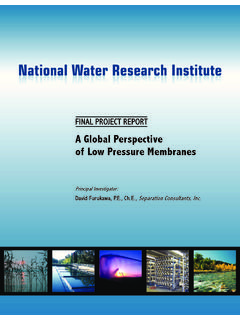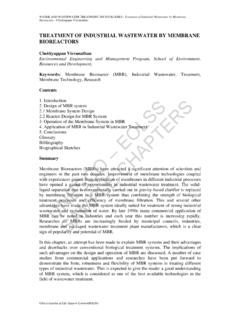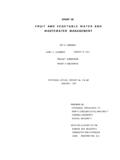Transcription of 4.0 Granular Activated Carbon - National Water …
1 Granular Activated CarbonDaniel Creek, Davidson, Nature of ProblemPast use of GAC to treat MTBE-impacted Water resulted in difficulties due to the physicaland chemical characteristics of MTBE. Results of several full-scale applications suggest thatsome GACs perform poorly when MTBE is present in the Water to be treated ( ,McKinnon and Dyksen, 1984; Creek and Davidson, 1998). In consideration of this, anin-depth evaluation is needed to identify the most promising GACs for MTBE removal andto define conditions under which GAC is most likely to be a cost-effective treatmentalternative for ObjectivesThe primary objective of this chapter is to provide a detailed feasibility analysis regardingthe use of GAC to remove MTBE from drinking Water . This feasibility analysis includesdetermining the conditions ( , MTBE influent concentrations, background Water quality)under which GAC is most likely to cost-effectively remove MTBE.
2 Other specific objectivesinclude the following: Clarify causes of the wide variability in existing data for MTBE removal using GAC. Determine state-of-knowledge regarding mass transfer parameters for different types ofGAC. Evaluate the impact of NOM and SOCs ( , benzene) on the adsorption of MTBE. Present state-of-knowledge regarding desorption of MTBE from address these objectives, this chapter presents general and detailed evaluations of GACfor treating MTBE-impacted Water . The general evaluation includes a focused literaturereview and a compilation of vendor information to determine the benefits and limitations ofGAC, key variables and design parameters, current usage of GAC for MTBE removal, detailed evaluation includes computer modeling results and cost estimates prepared todetermine the impacts of influent MTBE concentrations, background organic matter, and thepresence of other organic compounds upon the removal of MTBE using General Evaluation of GAC TechnologyThis section presents a general evaluation of using GAC for the treatment of MTBE.
3 A briefdescription of Carbon adsorption and its applications are presented, followed by discussionsof advantages and disadvantages; key variables and design parameters; GAC vendors;developmental status of technology ; ease of installation and operation; permitting; andcurrent usage of technology . This section also presents brief reviews of related research forMTBE treatment with Description of TechnologyCarbon adsorption technology is implemented by passing contaminated Water through avessel (or vessels) containing GAC. Intermolecular attraction between molecules of adissolved chemical (adsorbate) and the GAC (adsorbent) surface results in adsorptive forcesthat physically attract the adsorbate to the GAC as the Water passes through the vessel. Assuch, the adsorbate remains attached to the GAC matrix and the Water leaves the system witha decreased contaminant concentration. Chapter 5 presents further discussion of the primaryprocesses that govern for drinking Water applications is created from carbonaceous source materials, such asbituminous coal, coconut shell, petroleum coke, wood, and peat.
4 GAC is produced by grinding,roasting, and then activating the source materials with high temperature steam ( Water -gasreaction). This processing results in a porous material with very high internal surface each of the different source materials results in GACs with significantly differentadsorption properties. The adsorption potential of a given Carbon is dependent on numerousfactors, including the adsorption structure ( , pore sizes) and the characteristics of theadsorbate. Detailed discussions of these important GAC characteristics are presented innumerous references ( , Sontheimer et. al., 1988; Lehr, 1991; and, Nyer, 1992).To design an efficient Carbon adsorption system for Water treatment, a set of bench-scaleand/or pilot-scale tests using the site-specific Water is typically performed. These test resultsallow designers to optimize the type of GAC used and to estimate operating parameters forthe full-scale system.
5 Common types of bench-scale methods include isotherm tests (batchequilibrium tests) and dynamic column tests. These testing methods are discussed TestingIsotherm testing is performed to determine the relationship between adsorption capacity ofa GAC and concentration of an adsorbate under specific background Water conditions. Theresults of isotherm tests can be used to select the most effective GAC for specific waterconditions and to develop preliminary design testing, a static testing process, is performed by placing a measured amount of GACinto an aqueous solution containing a measured concentration of adsorbate. Afterequilibration, the adsorbate concentration in the Water is measured, allowing the adsorptioncapacity of the GAC to be calculated. The procedure is performed several times at varyinginitial adsorbate concentrations in order to develop the relationship between Carbon capacityand adsorbate concentration at a constant temperature.
6 This relationship can be describedusing the well-established Freundlich Isotherm Equation:q = KFCnwhere q is the mass of adsorbate per dry unit weight of Carbon [mg/g] and C is theconcentration in the bulk solution of the adsorbate at equilibrium. The Freundlich isothermparameters, KFand n, are experimentally determined constants at a given temperature. Ingeneral, it has been shown that the value of KFis related to the adsorbent capacity while thevalue of n is related to the strength of adsorption (Weber, 1972). Specific procedures forisotherm testing are presented in American Society for Testing and Materials (ASTM)Designation D 5919-96 (ASTM, 1996).Isotherm testing can be performed using distilled-deionized Water or site-specific Water thatincludes NOM and competing SOCs. The impacts of Carbon fouling by NOM and competi-tive interaction between SOCs are discussed later in this chapter (Section ).
7 It isimportant to note that in full-scale applications of Carbon adsorption, the GAC adsorptioncapacity for dissolved contaminants typically is lower than the maximum adsorption capacitydetermined from isotherm Column TestingAlthough analytical models that incorporate parameters determined from isotherm testingcan be used to predict full-scale results, it usually is better to perform dynamic testing toquantify kinetic effects with site-specific Water . Because of this, the design of carbonadsorption systems may be preceded by dynamic column testing with the selected GAC andthe site Water . These tests can also determine the need for pretreatment of the Water prior tocarbon testing is performed with a set of GAC columns connected in series, using eitherthe rapid small-scale column test (RSSCT) method or the accelerated column test (ACT)method. Samples taken at the effluent end of the columns allow development of concentra-tion breakthrough curves that are dependent on flow conditions in addition to GAC type andinfluent adsorbate concentration.
8 These test results can be used for full-scale design throughthe use of scaling relationships and allow for evaluation of EBCT, length of the mass transferzone (MTZ), and other critical design variables impacted by dynamic effects. Crittenden etal. (1989) present procedures and scaling relationships for the RSSCT method, which iscurrently being refined for presentation as an ASTM standard test method that is expected to214be finalized in the year 2000 (Graham, personal communication, 1999). Detailed discussionsof column testing are presented in numerous references (Stenzel and Merz, 1988; Crittendenet al., 1991; and, Hand et al., 1989). Full-scale OperationsCarbon adsorption systems can be used in various configurations ( , in-series, in-parallel,upflow, downflow). In general, adjusting the system configuration allows designers tooptimize the adsorption characteristics and cost-effectiveness of the system based on theinfluent Water conditions ( , adsorbate properties, flow rate), effluent treatment criteria,and regeneration/replacement methods.
9 These design considerations for full-scale GACsystems are discussed in numerous references ( , Sontheimer et al., 1988; Hand et al.,1989; Nyer, 1992).Single vessel treatment systems are the simplest applications of GAC technology . Thesesystems are often used in situations with low flow rates, low influent concentrations, or lessstringent effluent criteria. In single vessel treatment systems (or in the lead vessel of an in-series system), the MTZ (see Figure 5-11 in Chapter 5) of the adsorbate moves down gradientas the GAC at the influent end of the vessel becomes saturated with adsorbate. Eventually,the MTZ of the adsorbate moves far enough into the vessel that measurable concentrationsof adsorbate are observed in the effluent ( , breakthrough ). When the effluent from asingle-vessel system reaches a specified adsorbate concentration, the vessel is taken off-lineand the Carbon is replaced. As shown in Figure 5-11, not all of the GAC will be saturated atbreakthrough because of the shape of the MTZ.
10 This limits the removal effectiveness ofsingle-vessel systems and necessitates shutdown of the treatment system until new orregenerated Carbon can be replaced into the single 4-1 presents a schematic of in-series operation, which is often used for public drinkingwater systems. In-series operation allows the secondary, or lag, vessel(s) to maintain finaleffluent quality while GAC in the lead vessel is used to remove the majority of the adsorbatedissolved in the influent Water . Once effluent concentrations from the lead vessel reach aspecified level ( , 50 percent or more of the influent concentration), the lead vessel is takenoff-line, replaced with fresh Carbon , and then put back on-line as the lag vessel. Properchange-out of an in-series GAC system ensures that the MTZ of the adsorbate does not reachthe effluent end of the lag vessel, thereby ensuring non-detectable concentrations in thesystem effluent at all times.







